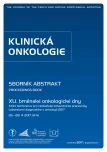Circulating Myeloid Suppressor Cells and Their Role in Tumour Immunology
Authors:
K. Pilátová 1,2; E. Budinská 1; B. Bensciková 1,3; R. Nenutil 1,4; R. Šefr 1,5; L. Fědorová 1,2; B. Hanáková 1; V. Brychtová 1; L. Zdražilová Dubská 1,2
Authors‘ workplace:
RECAMO, Masarykův onkologický ústav, Brno
1; Oddělení laboratorní medicíny, Masarykův onkologický ústav, Brno
2; Klinika komplexní onkologické péče, Masarykův onkologický ústav, Brno
3; Oddělení onkologické patologie, Masarykův onkologický ústav, Brno
4; Klinika operační onkologie, Masarykův onkologický ústav, Brno
5
Published in:
Klin Onkol 2017; 30(Supplementum1): 166-169
Category:
Article
Overview
Background:
Myeloid-derived suppressor cells (MDSCs) are heterogenic population of multipotent progenitors of myeloid lineage. For their immunosuppressive effect, MDSC are responsible for tumour escape from the host immune surveillance. Furthermore, MDSCs support tumour by promotion of angiogenesis and metastasis. Membrane markers of human MDSCs are myeloid markers CD11b and CD13, these cells are HLA-Drlow/– and expression of CD15 or CD14 differentiate them into granulocytic (Gr-MDSCs) and monocytic (Mo-MDSCs), resp.
Patients and Methods:
Using flow cytometry, we investigated Mo-MDSC counts in peripheral blood of non-cancer individuals – control group (n = 61), breast (n = 39) and colorectal (n = 52) cancer patients. These cells were detected as CD45+CD11b+CD33+CD14+HLA-Drlow/– and quantified as percentage of total white blood cells and as absolute count.
Results:
In control group, circulating Mo-MDSCs was gender-and age-independent and the average value was 1.09% and 0.073 × 109/l. Breast cancer patients had higher circulating Mo-MDSCs compared to control group with average values: 3.57% and 0.229 × 109/l (p < 0.001) and we also observed increase in Mo-MDSC number after granulopoietic growth factors administration (p = 0.043). Colorectal cancer patients had higher average number of circulating Mo-MDSCs compared to control group: 1.71% a 0.125 × 109/l (p = 0.003) and its number did not correlate with tumour clinicopathological stage, localization of primary tumour (colon vs. rectum), site (left vs. right) and microsatellite instability.
Conclusion:
Increased number of MDSCs in circulation and within tumour microenvironment has been associated with immune suppression and tumour progression. Colorectal cancer patients at diagnosis showed higher circulating Mo-MDSCs possibly reflecting immunosuppressive effect of tumour microenvironment. Change of Mo-MDSC number from baseline level need to be evaluated in the context of CRC patients outcome. Recombinant granulopoietic growth factors increase number of circulating Mo-MDSCs and the effect of this phenomenon on cancer prognosis remains to be elucidated.
Key words:
myeloid-derived suppressor cells – colorectal cancer – breast cancer – immunology – immunosuppression – G-CSF
This work was supported by MEYS by NPU I (LO1413), grant AZV 16-31966A and MH DRO 00209805.
The authors declare they have no potential conflicts of interest concerning drugs, products, or services used in the study.
The Editorial Board declares that the manuscript met the ICMJE recommendation for biomedical papers.
Submitted:
11. 3. 2017
Accepted:
26. 3. 2017
Sources
1. Marvel D, Gabrilovich DI. Myeloid-derived suppressor cells in the tumor microenvironment: expect the unexpected. J Clin Invest 2015; 125 (9): 3356–3364. doi: 10.1172/JCI80005.
2. Talmadge JE, Gabrilovich DI. History of myeloid-derived suppressor cells. Nat Rev Cancer 2013; 13 (10): 739–752. doi: 10.1038/nrc3581.
3. Yu J, Du W, Yan F et al. Myeloid-derived suppressor cells suppress antitumor immune responses through IDO expression and correlate with lymph node metastasis in patients with breast cancer. J Immunol 2013; 190 (7): 3783–3797. doi: 10.4049/jimmunol.1201449.
4. OuYang LY, WU XJ, Ye SB et al. Tumor-induced myeloid-derived suppressor cells promote tumor progression through oxidative metabolism in human colorectal cancer. J Transl Med 2015; 13: 47. doi: 10.1186/s12967-015-0410-7.
5. Solito S, Marigo I, Pinton L et al. Myeloid-derived suppressor cell heterogeneity in human cancers. Ann N Y Acad Sci 2014; 1319 (1): 47–65. doi: 10.1111/nyas.12 469.
6. Shojaei F, Wu X, Qu X et al. G-CSF-initiated myeloid cell mobilization and angiogenesis mediate tumor refractoriness to anti-VEGF therapy in mouse models. Proc Natl Acad Sci U S A 2009; 106 (16): 6742–6747. doi: 10.1073/pnas.0902280106.
7. Li W, Zhang X, Chen Y et al. G-CSF is a key modulator of MDSC and could be a potential therapeutic target in colitis-associated colorectal cancers. Protein Cell 2016; 7 (2): 130–140. doi: 10.1007/s13238-015-2.
8. Aliper AM, Frieden-Korovkina VP, Buzdin A et al. A role for G-CSF and GM-CSF in nonmyeloid cancers. Cancer Med 2014; 3 (4): 737–746. doi: 10.1002/cam4. 239.
9. Kowanetz M, Wu X, Lee J et al. Granulocyte-colony stimulating factor promotes lung metastasis through mobilization of Ly6G+Ly6C+ granulocytes. Proc Natl Acad Sci U S A 2010; 107 (50): 21248–21255. doi: 10.1073/pnas.1015855107.
10. Altundag K, Altundag O, Elkiran ET et al. Addition of granulocyte-colony stimulating factor (G-CSF) to adjuvant treatment may increase survival in patients with operable breast cancer: interaction of G-CSF with dormant micrometastatic breast cancer cells. Med Hypotheses 2004; 63 (1): 56–58.
11. Meyer C, Cagnon L, Costa-Nunes CM et al. Frequencies of circulating MDSC correlate with clinical outcome of melanoma patients treated with ipilimumab. Cancer Immunol Immunother 2014; 63 (3): 247–257. doi: 10.1007/s00262-013-1508-5.
12. Finke J, Ko J, Rini B et al. MDSC as a mechanism of tumor escape from Sunitinib mediated anti-angiogenic therapy. Int immunopharmacol 2011; 11 (7): 856–861. doi: 10.1016/j.intimp.2011.01.030.
13. Wesolowski R, Markowitz J, Carson W 3rd. Myeloid derived suppressor cells – a new therapeutic target in the treatment of cancer. J Immunother Cancer 2013; 1 (1): 10. doi: 10.1186/2051-1426-1-10.
Labels
Paediatric clinical oncology Surgery Clinical oncologyArticle was published in
Clinical Oncology

2017 Issue Supplementum1
Most read in this issue
- Ascites May Provide Useful Information for Diagnosis of Ovarian Cancer
- Lactate Dehydrogenase – Old Tumour Marker in the Light of Current Knowledge and Preanalytic Conditions
- Molecular Pathology of Colorectal Cancer, Microsatellite Instability – the Detection, the Relationship to the Pathophysiology and Prognosis
- Circulating Myeloid Suppressor Cells and Their Role in Tumour Immunology
